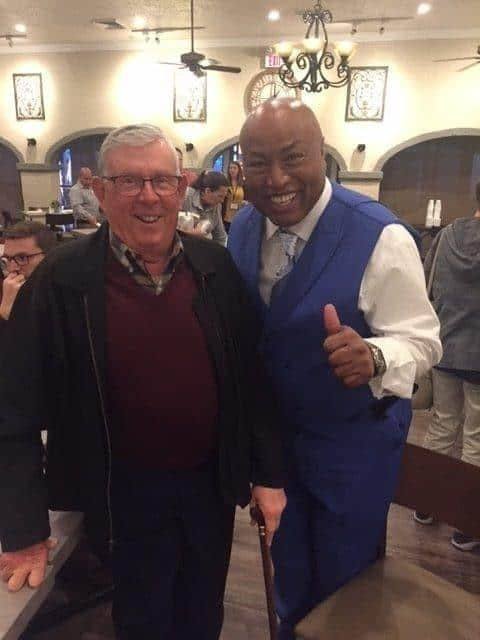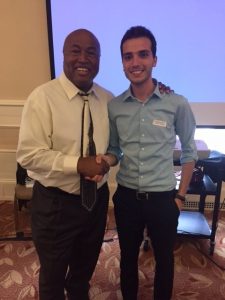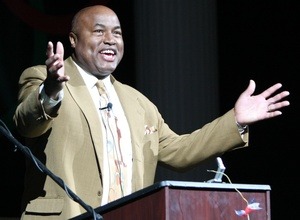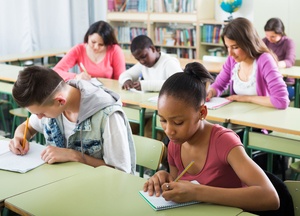
How to Choose the Right Back-to-School Speaker
How to Choose the Right Back-to-School Speaker
 Are your teachers excited to return to the classroom after summer vacation?
Are your teachers excited to return to the classroom after summer vacation?
Are they looking forward to getting back with their students and getting them motivated to learn?
Believe it or not, a great back–to–school speaker can deliver those results. That’s why selecting the right speaker is so important. Your back-to-school convocation or event sets the tone for your school or district for the rest of the year. It’s extremely important that your teachers leave feeling inspired, motivated, and excited to start the year.
The next question, then, is how do you choose the right back-to-school speaker? There are three important steps to take during your search.
1. Visit the Speaker’s Website
You’ll want to research the speaker in question to gather as much information as possible. From perusing the website, you can hopefully identify the message or perspective the speaker portrays.
Is this message one that is in sync with your message? View the videos on the website to see the style of delivery the speaker uses. Does this style work with your audience?
2. Read Reviews and Follow Up with References
Read the references on the website and even email or call a few of the references with critical questions you would like answers to.
If a speaker did a good job, people are willing to share this information with other educators because they understand the challenge of finding a good speaker.
3. Schedule a Call with the Speaker
Call the prospective speaker and have a conversation. You can learn much about a speaker this way.
You can pick up on their tone and their perspective and get a feel for their level of comfort in addressing the theme you want delivered.
In addition to the above three steps, there are four things to keep in mind when searching for a speaker and conducting your research.
Is the Speaker Relatable?
Will your teachers feel that the speaker has walked in their shoes? Look for someone that has spent time in the classroom. The length of time isn’t necessarily important, but teachers are more likely to listen to someone who has been there. They want to listen to someone who understands the challenges, idiosyncrasies, and nuances of the classroom.
Is the Speaker Engaging?
You don’t want a speaker that will bore your audience. Regardless of how relatable a speaker is, teachers don’t want to be bored out of their gourd, so to speak.
Check references to see if words such as inspiring, up-tempo, or engaging are used to describe the prospective speaker’s presentation. My belief is that you cannot inspire people by boring them to death. You do not have to look for a standup comedian by any means, but a little humor and levity goes a long way towards keeping the attention of your audience.
Does the Speaker Have Credibility?
Make sure the speaker is thoroughly familiar with the topic and can provide new insights that complement your theme for the year. The speaker should be someone who has experienced success with the material, can document that success, and show your audience how they, too, can have that same type of success with the topic.
Does the Speaker Involve the Audience?
People love it when they or a colleague is involved in the presentation. Actually, this models what teachers need to be doing in the classroom with their own students!
This engagement makes the audience pay closer attention and helps the group make a connection with the speaker. It doesn’t have to be a very long interaction, but should be interspersed at critical and appropriate junctures.
A speaker who stands and reads an entire speech from their notes or who relies on overheads as the major connecting point won’t have the same impact as a speaker who can involve the audience in the presentation. Keep this concept in mind as you read the reviews or references of the speaker.
It is sometimes a challenge to find a speaker that can deliver your message and energize and inspire the audience. But this should be the standard for all back-to-school events. Our teachers deserve no less and our students will reap the benefits!





 It’s often difficult to do your best work and stay motivated with so many things pulling at you every day. However, you can make it through challenging times and inspire your class to love learning!
It’s often difficult to do your best work and stay motivated with so many things pulling at you every day. However, you can make it through challenging times and inspire your class to love learning!
 Many teachers struggle with feeling as though their students just aren’t motivated. The advice “Don’t wait on a blessing, be one” is a perfect way to approach students who seem unmotivated.
Many teachers struggle with feeling as though their students just aren’t motivated. The advice “Don’t wait on a blessing, be one” is a perfect way to approach students who seem unmotivated.
 Have you ever read a joke and laughed out loud? Have you ever read a quote and truly thought about it’s meaning? Have you ever read a book that you could not put down? Words matter. Words are powerful. They can shape the future of a child.
Have you ever read a joke and laughed out loud? Have you ever read a quote and truly thought about it’s meaning? Have you ever read a book that you could not put down? Words matter. Words are powerful. They can shape the future of a child.  This is one of the reasons why I have had a concern about the term “at-risk” when we refer to students. I am well aware that many students are “at risk” for failing or dropping out. Yet, these students are so much more than “at risk.” They are indeed “at promise.” They have the ability to be successful and productive members of our communities. What they need is support. With the proper support we know they can go far!
This is one of the reasons why I have had a concern about the term “at-risk” when we refer to students. I am well aware that many students are “at risk” for failing or dropping out. Yet, these students are so much more than “at risk.” They are indeed “at promise.” They have the ability to be successful and productive members of our communities. What they need is support. With the proper support we know they can go far!  I returned this month to
I returned this month to 
 Another way to get students excited is to get them talking about themselves. Ask students to verbally explain, write a paragraph, or even create a song or rap about how they may be familiar with the topic you’re teaching. In science when I talked about waves and oceans, I often had my students write two or three paragraphs about an experience they had interacting with waves or with any body of water. Then I would show them how they were impacted by waves and by the way oceans, lakes, or streams operate. This was a great segue to the discussion of the day.
Another way to get students excited is to get them talking about themselves. Ask students to verbally explain, write a paragraph, or even create a song or rap about how they may be familiar with the topic you’re teaching. In science when I talked about waves and oceans, I often had my students write two or three paragraphs about an experience they had interacting with waves or with any body of water. Then I would show them how they were impacted by waves and by the way oceans, lakes, or streams operate. This was a great segue to the discussion of the day.
 Classroom
Classroom
 All
All